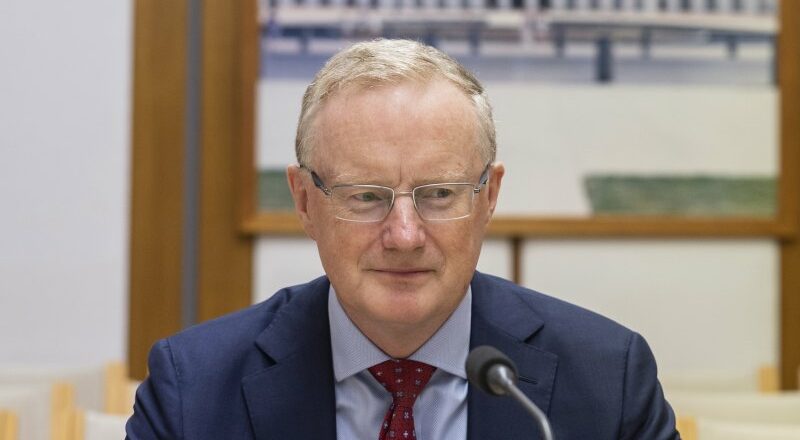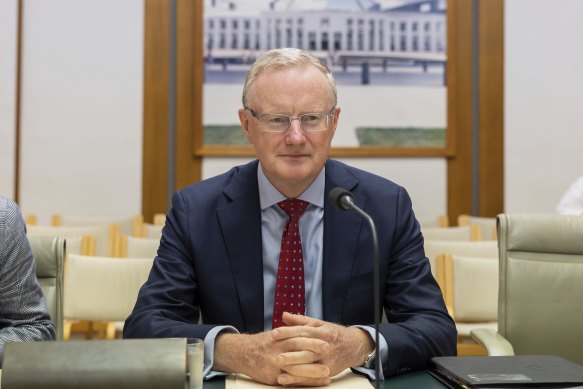Will Lowe take the inflation bait and keep rates on hold?
Thanks to February’s unexpectedly large fall in inflation, the Reserve Bank now has an excuse to leave interest rates on hold. But the question remains whether governor Philip Lowe will use it.
Suffice to say, the RBA’s popularity will sink to new lows if the latest inflation data is not enough for the central bank’s board to seal the deal on a rate pause when it meets next Tuesday.
A cacophony of critics continues to comment on the damage wreaked by the rapid-fire rate rises on some sections of the community. And borrowers are begging from some space to exhale.
On Friday, RBA governor Philip Lowe faced a parliamentary committee for the second time.Credit:Alex Ellinghausen
Until recently, the biggest risk the RBA faced was being unable to tame runaway inflation. But adding another rate hike to 10 successive jumps potentially shifts the risk balance into damaging the economy territory. There are legitimate concerns that if the RBA continues to pump the rate accelerator it won’t have the time to gauge the lag effects from the rate increases it has already imposed.
The RBA, like plenty of other central banks, has got form when it comes to being too slow to change course on rates, most recently in 2022 when it arrived too late to the monetary tightening party.
Meanwhile, the US and European banking crisis over the past couple of weeks will also factor into the RBA’s decision. While Australian banks are considered in rude health and largely immune from the overseas ructions, any offshore squeeze on credit will slow the global economy – and ultimately bleed into Australia.
The latest Australian inflation figures show the central bank has gained considerable traction in its attempts to slow down spending and puncture the demand bubble.
The tepid growth in retail sales released earlier this week indicates that retail volumes are set to go backwards in the March quarter.
But the RBA will also be influenced by the latest labour market read, which shows unemployment has remained stubbornly low. That will feature as a large tick in the column for continuing to raise rates.
That said, the February inflation data released on Wednesday adds another dot point to what is clearly a downward trend in inflation. It is significantly less threatening. In February, inflation rose by 6.8 per cent – that’s a decent improvement on the 7.2 per cent figure for the 12 months to January and the 8.8 per cent in December.
Sure, inflation remains elevated above the target 2 to 3 per cent band, but it is not expected to return to that level before 2025.
Not surprisingly, economists were hedging their bets, with Wednesday’s inflation figures pushing more of them into the ‘pause’ side of the ledger. And markets are unequivocally punting on rates being held at 3.6 per cent.
The case for leaving rates on hold is buttressed by the fact that many of the biggest contributors to February inflation came from essential categories. Food and non-alcoholic beverages were up 8 per cent, housing rose 9.9 per cent, and electricity was up 17 per cent. The price increases in these categories are largely driven by supply rather than excess demand.
The discretionary categories like clothing (up 3.7 per cent) and alcohol (up 4.5 per cent) showed much clearer signs of slowing in as consumers tapered their spending.
The softer demand for discretionary spending is still not showing up in the trading figures of many retailers. Premier Retail’s results, released this week, printed a 7.7 per cent rise in sales for February and early March.
Commentary from other retailers like Myer and David Jones also points to largely robust sales this calendar year.
But even if the RBA decides to take a breather on rates in April, it doesn’t necessarily mean that will mark the end of the monetary tightening cycle. May will demand a fresh test of the RBA’s resolve.
The Market Recap newsletter is a wrap of the day’s trading. Get it each weekday afternoon.
Most Viewed in Business
From our partners
Source: Read Full Article


